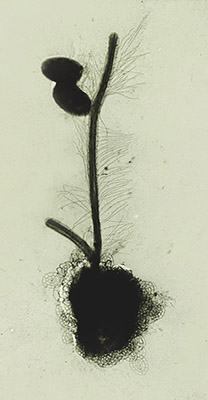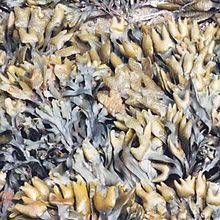Heterokonta
Heterokonta atau stramenopila adalah suatu cabang utama eukariota[8] yang sekarang mencakup sekitar 10.500 spesies yang dikenal.[9] Kebanyakan anggotanya berupa alga, mulai dari kelp raksasa multiseluler hingga diatom yang uniseluler, yang merupakan penyusun fitoplankton yang utama. Anggota Stamenopila lainnya yang terkenal adalah (umumnya parasit) Oomycetes, termasuk Phytophthora (penyebab penyakit hawar daun dan batang) dan juga Pythium yang menyebabkan busuk akar (upas).
| Heterokonta
| |
|---|---|
| Stramenopiles | |
| Taksonomi | |
| Superkerajaan | Eukaryota |
| Tanpa nilai | Stramenopiles |
| Tata nama | |
| Sinonim takson | |
| Kelas-kelas yang tipikal | |
| |
Nama heterokonta merujuk pada tahap daur hidup motil (bergerak aktif). Gulma laut yang biasa melekat atau terapung di air berada pada tahap stasioner (menetap). Pada tahap motil, sel alga mempunyai dua flagela yang panjangnya berbeda (heteros = berbeda).

Rujukan
- ^ Patterson, D. J. (1989). Stramenopiles: Chromophytes from a protistan perspective. in The Chromophyte Algae: Problems and Perspectives. Green, J.C., Leadbeater, B. S. C. and Diver, W. L. (eds.), Clarendon Press, Oxford, UK.
- ^ Vørs, N (1993). "Marine heterotrophic amoebae, flagellates and heliozoa from Belize (Central America) and Tenerife". Journal of Eukaryotic Microbiology. 40: 272–287. doi:10.1111/j.1550-7408.1993.tb04917.x.
- ^ David, J. C. (2002). A preliminary catalogue of the names of fungi above the rank of order. Constancea 83: 1–30, [1].
- ^ van den Hoek, C., Mann, D.G. and Jahns, H.M. (1995). Algae An Introduction to Phycology. Cambridge University Press, Cambridge. ISBN 0-521-30419-9.
- ^ Alexopoulos, C. J., Mims, C. W. and Blackwell, M. (1996). Introductory Mycology, 4th ed. New York: J. Wiley.
- ^ Dick, M. W. (2001). Straminipilous fungi. Dordrecht, the Netherlands: Kluwer Academic Publishers. 670 p., [2].
- ^ "Stramenipila M.W. Dick (2001)". MycoBank. International Mycological Association.
- ^ "stramenopiles". Diakses tanggal 2009-03-08.
- ^ "Major Algae Phyla". Diarsipkan dari versi asli tanggal 2009-08-20. Diakses tanggal 2009-04-05.
Bacaan lanjutan
- Fletcher, R.L.1987. Seaweeds of the British Isles. Volume 3 Fucophyceae (Phaeophyceae) Part 1. British Museum (Natural History, London. ISBN 0-565-00992-3
Pranala luar
Wikispecies mempunyai informasi mengenai Heterokonta.
